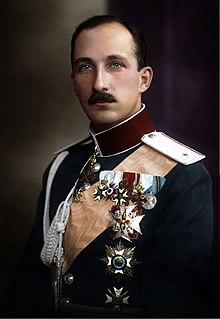
Boris III, originally Boris Klemens Robert Maria Pius Ludwig Stanislaus Xaver, was the Tsar of the Kingdom of Bulgaria from 1918 until his death.

The Red Skull is an alias used by several fictional characters appearing in American comic books published by Marvel Comics, primarily Johann Schmidt. The first Red Skull appeared in Captain America Comics #1, created by Joe Simon and Jack Kirby. Usually portrayed as a Nazi agent and protégé of Adolf Hitler who is disfigured or wearing a red skull mask, the Red Skull is regarded as the archenemy of the superhero Captain America.

Events from the year 1940 in Canada.

Events from the year 1942 in Canada.

Events from the year 1943 in Canada.
Baron Wolfgang von Strucker is a fictional supervillain appearing in American comic books published by Marvel Comics. A former Nazi officer, he is one of the leaders of Hydra terrorist organization and an enemy of S.H.I.E.L.D., the Avengers, and the interests of the United States of America and thus a fugitive. He has been physically augmented to be nearly ageless. While Strucker has been seemingly killed in the past, he returned to plague the world with schemes of world domination and genocide, time and time again.

John Cassaday is an American comic book artist, writer, and television director, best known for his work on Planetary, Astonishing X-Men, Captain America and Star Wars. He has received multiple Eagle and Eisner Awards and nominations for his work.
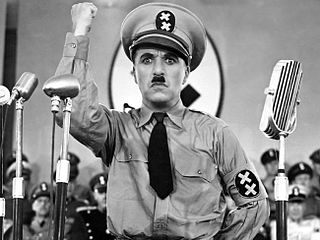
Adolf Hitler was the leader of the National Socialist German Workers' Party and Chancellor of Nazi Germany from 1933 to 1945. Hitler has been represented in popular culture ever since he became a well-known politician in Germany. His distinctive image was often parodied by his opponents. Parodies became much more prominent outside Germany during his period in power. Since the end of World War II representations of Hitler, both serious and satirical, have continued to be prominent in popular culture, sometimes generating significant controversy. In many periodicals, books, and movies, Hitler and Nazism fulfill the role of archetypal evil. This treatment is not confined to fiction but is widespread amongst nonfiction writers who have discussed him in this vein. Hitler has retained a fascination from other perspectives; among many comparable examples is an exhibition at the German Historical Museum which was widely attended.

Men's adventure is a genre of magazine that was published in the United States from the 1940s until the early 1970s. Catering to a male audience, these magazines featured pin-up girls and lurid tales of adventure that typically featured wartime feats of daring, exotic travel or conflict with wild animals. These magazines were also colloquially called "armpit slicks", "men's sweat magazines" or "the sweats", especially by people in the magazine publishing or distribution trades.
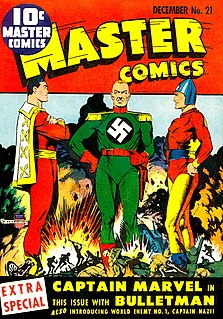
Captain Nazi is a Fawcett Comics and DC Comics supervillain, a rival of Captain Marvel and Captain Marvel Jr.. As Baron Krieger, Captain Nazi made his first live-action appearance in a 2016 second season episode of The CW TV series DC's Legends of Tomorrow, played by André Eriksen.

"Operation: Galactic Storm" is a 19-part comic book crossover storyline which ran through Marvel Comics' Avengers related titles - Avengers, Avengers West Coast, Captain America, Iron Man, Thor, Wonder Man, and Quasar - between March and May 1992.
Notable events of 1984 in comics. See also List of years in comics.
Thrilling Publications, also known as Beacon Magazines (1936–37), Better Publications (1937–43) and Standard Magazines (1943–55), was a pulp magazine publisher run by Ned Pines, publishing such titles as Startling Stories and Thrilling Wonder Stories.
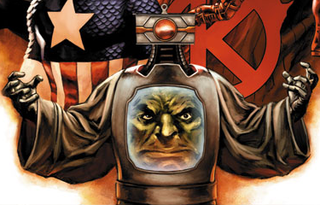
Arnim Zola is a fictional supervillain appearing in American comic books by Marvel Comics. He is a master of biochemistry and is an enemy of Captain America and the Avengers. He first appeared in Captain America #208, created by writer/artist Jack Kirby. He was originally a Nazi biochemist during World War II and survived into the modern age by transferring his conscious mind into the body of a sophisticated robot which protected it by storing it in its chest and displaying a digital image of Zola's face on its chest plate.
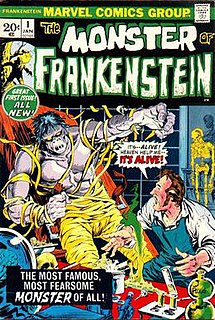
Frankenstein's Monster is a fictional character appearing in American comic books published by Marvel Comics. The character is based on the character in the novel Frankenstein by Mary Shelley. The character has been adapted often in the comic book medium.
Notable events of 1991 in comics. See also List of years in comics.
Magazine Management Co., Inc. was an American publishing company lasting from at least 1947 to the early 1970s, known for men's-adventure magazines, risque men's magazines, humor, romance, puzzle, celebrity/film and other types of magazines, and later adding comic books and black-and-white comics magazines to the mix. It was the parent company of Atlas Comics, and its rebranded incarnation, Marvel Comics.

Marjorie M. Liu is an American New York Times best-selling author and comic book writer. She is acclaimed for her horror fantasy comic Monstress, and her paranormal romance and urban fantasy novels including The Hunter Kiss and Tiger Eye series. Her work for Marvel Comics include NYX, X-23, Dark Wolverine, and Astonishing X-Men. In 2015 Image Comics debuted her creator-owned series Monstress, for which she was nominated for an Eisner Award for Best New Series. In 2017 she won a Hugo Award for the first Monstress trade paperback collection. In July 2018 she became the first woman in the 30-year history of the Eisner Awards to win the Eisner Award for Best Writer for her work on Monstress, though she shared the award with writer Tom King, who won for his work on other books.

Avengers 1959 is a 2011 five issue comic book miniseries written and drawn by Howard Chaykin. The story takes place in 1959 and concerns Nick Fury leading an early incarnation of the Avengers who hunt down Nazi war criminals who escaped justice after World War II. The team consists of Nick Fury, Dum Dum Dugan, Sabretooth, Dominic Fortune, Namora, Kraven the Hunter, Ulysses Bloodstone, Silver Sable, and the Blonde Phantom.

The Punisher War Zone is a comic book series published by Marvel Comics about the vigilante The Punisher. The series was written and drawn by several artists during its run. The series lasted for 41 issues. It was the first series of The Punisher War Zone title history and lasted from 1992 to 1995. The vast majority of the series was written by Chuck Dixon. Besides John Romita Jr. who worked a lot on the series, several other artists painted the covers, among them Rainier "Rain" Beredo, John Buscema and Joe Kubert.













